Section 2 - Scientific Method
Download as ppt, pdf0 likes1,356 views
The document provides information on scientific equipment, measurement units, the scientific method, experimental design, and graphing. It defines common lab tools like graduated cylinders, pipettes, and microscopes. It explains units of measurement for mass, length, and temperature. It describes the key parts of the scientific method and experimental design, including the importance of controls, placebos, independent and dependent variables. It also gives brief descriptions of line graphs, bar graphs and pie charts.
1 of 27
Downloaded 22 times

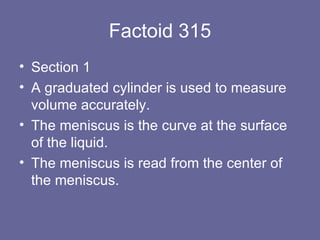
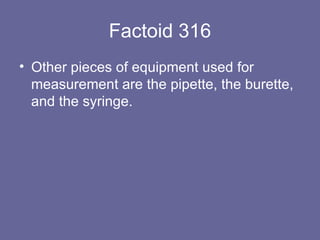

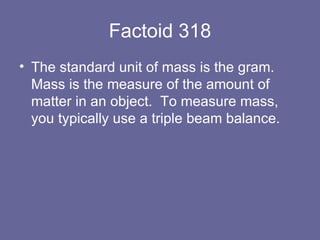
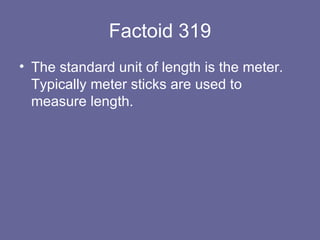
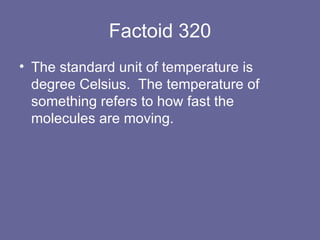

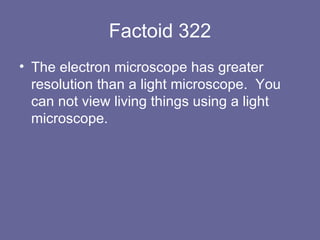
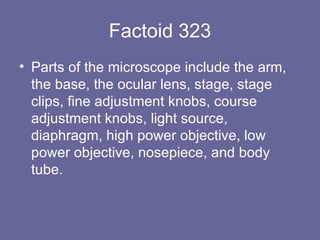
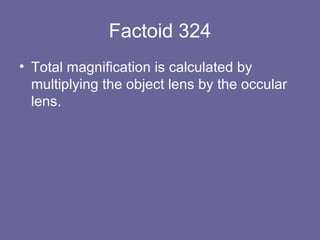
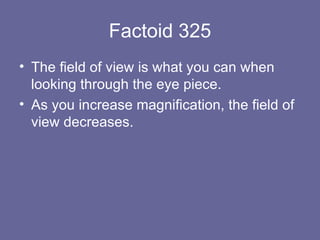
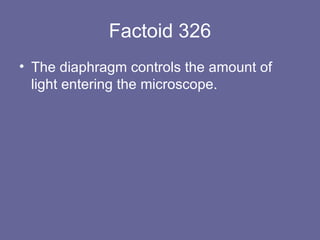
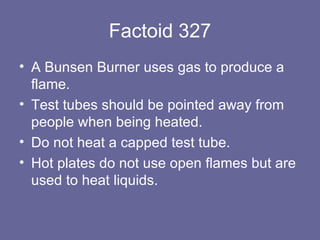
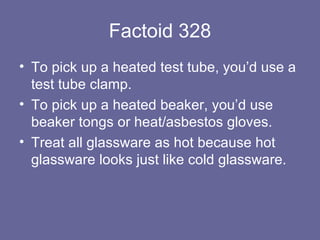
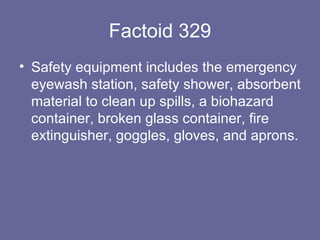
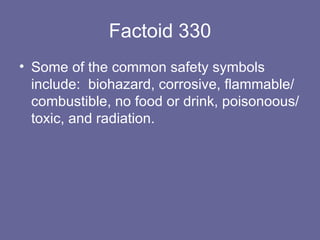




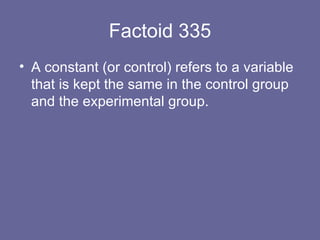
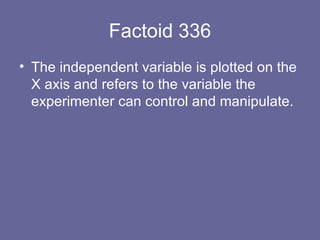
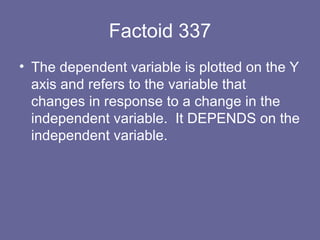


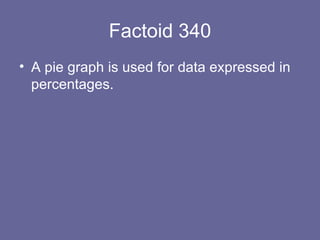
Ad
Recommended
Section 1 - Tools of Science and Lab Safety
Section 1 - Tools of Science and Lab SafetyWesley McCammon
╠²
A graduated cylinder is used to accurately measure volume, with the meniscus read from the center of the curve at the liquid's surface. Other common measurement tools include pipettes, burettes, and syringes, while test tubes, beakers and Erlenmeyer flasks are used to store liquids rather than measure. Standard units of measurement include grams for mass measured using a triple beam balance, meters for length typically using a meter stick, and degrees Celsius for temperature referring to molecular motion speed.EXPERIMENTAL INVESTIGATION ON EFFECTS OF HEAT FLUX AND DENSITY ON SMOLDERING ...
EXPERIMENTAL INVESTIGATION ON EFFECTS OF HEAT FLUX AND DENSITY ON SMOLDERING ...AM Publications
╠²
The document presents an experimental investigation into the effects of heat flux and density on the smoldering of cotton, highlighting the relationship between ignition temperature and these variables. It describes three heat flux scenarios and their impact on ignition temperature for cotton samples of varying densities, concluding that increased density raises ignition temperature while higher heat flux lowers it. The study emphasizes that both parameters should be considered in materials testing standards for ignition temperatures.Chapter 11 Review Questions
Chapter 11 Review QuestionsWesley McCammon
╠²
The document contains 20 multiple choice questions about eating disorders such as anorexia nervosa and bulimia nervosa. It tests knowledge about the defining characteristics, diagnostic criteria, risk factors, and signs/symptoms of these disorders. Some key points covered include that anorexia nervosa mainly affects adolescent and young adult females, involves distorted body image and denial of hunger, and can become life threatening if body weight drops below 75% of normal. Bulimia is characterized by binge eating followed by purging behaviors.Chapter 9 Notes
Chapter 9 NotesWesley McCammon
╠²
This document summarizes key minerals and their functions in the human body. It discusses how minerals like calcium, phosphorus, iron, and zinc are absorbed and transported in the body. It also outlines the dietary needs and food sources of important minerals, and consequences of both mineral deficiencies and toxicities.Chapter 09 Review Questions
Chapter 09 Review QuestionsWesley McCammon
╠²
This document contains 20 multiple choice questions about water, minerals, and electrolytes from Chapter 9 of Wardlaw's Contemporary Nutrition textbook. The questions cover topics like the percentage of body weight made up of water, what controls water levels in different body compartments, daily water needs for men and women, sodium content in typical American diets, roles of potassium and sodium, and effects of high salt consumption.Chapter 10
Chapter 10Wesley McCammon
╠²
This document contains 20 multiple choice questions from Chapter 10 of Wardlaw's Contemporary Nutrition textbook. The questions cover topics like the benefits of physical fitness, sources of cellular energy, aerobic vs anaerobic metabolism, protein and carbohydrate needs for athletes, weight management strategies, and carbohydrate loading for endurance events.Chapter 15 and 16
Chapter 15 and 16Wesley McCammon
╠²
The document summarizes several biogeochemical cycles including the water, carbon, oxygen, and nitrogen cycles. It also discusses ecological succession, population growth, human impacts on ecosystems such as algal blooms, biological magnification, and global warming. Key elements like carbon, oxygen, hydrogen, and nitrogen are recycled through these natural processes.Section11
Section11Wesley McCammon
╠²
This document provides 200 facts about taxonomy and the classification of organisms. It discusses the 7 levels of biological classification from kingdom to species. Scientific names use binomial nomenclature, consisting of the genus and species names. Viruses are not considered living organisms and are not classified within the traditional biological taxonomy. The four main kingdoms are Archaebacteria, Eubacteria, Protista, and Fungi. Each kingdom has distinguishing characteristics.Laboratory equipment self review 2013
Laboratory equipment self review 2013sinnes
╠²
The document lists and describes various pieces of lab equipment used for microscopy, chemistry experiments, and dissection. Key equipment includes microscopes for examining specimens, microscope slides for preparing samples, beakers and flasks for holding or heating liquids, graduated cylinders and pipettes for measuring small volumes, burners and stands for heating substances, and tools like forceps, scalpels, and needles for dissection. Safety equipment like goggles and balances are also mentioned.Laboratory equipment self review 2013
Laboratory equipment self review 2013sinnes
╠²
The document lists and describes various pieces of laboratory equipment used in experiments and specimen preparation including microscopes for viewing specimens, microscope slides and reagent bottles for holding samples, Florence flasks and beakers for liquid storage and heating, graduated cylinders and pipettes for measuring liquids, test tubes and test tube racks for chemical testing, petri dishes for culturing microorganisms, thermometers for temperature measurement, ring stands and wire gauze for apparatus support, mortar and pestles for grinding, Bunsen burners for heating, forceps and scalpels for dissection, and balances for mass measurement.Tools_of_the_Biologist.ppt slides presentation
Tools_of_the_Biologist.ppt slides presentationrolanaribato30
╠²
The document describes various tools and equipment used by biologists in the laboratory, including tools for measuring length and volume, dissection, observing specimens under the microscope, handling chemicals, and safety equipment. Key pieces of equipment are graduated cylinders and pipettes for measuring volume, balances for measuring mass, microscopes for examination, and safety goggles and gloves for protection. The document provides instructions for using these tools properly.BIOLOGY FORM 1 Notes.pptx
BIOLOGY FORM 1 Notes.pptxMgungweFrank
╠²
This document provides information on research skills, safety measures in the biology laboratory, handling accidents, safe use of apparatus including glassware and burners, laboratory warning symbols, parts and use of the light microscope, magnification, resolution, field of view, units of measurement, and study skills for learning science. Key safety rules for the laboratory include never running, eating, or playing, following experimental procedures, wearing protective equipment, and properly disposing of materials.Equip activity
Equip activityvjcummins
╠²
This document provides an overview of basic laboratory equipment used in scientific experiments. It describes various pieces of equipment such as beakers, Bunsen burners, cover slips, dissecting tools, microscopes, petri dishes, pipettes, rulers, safety goggles, test tubes, balances, and flasks. Each item is briefly defined and its purpose and proper use are stated. The document serves as an introduction to common laboratory tools and equipment.Equip activity
Equip activityvjcummins
╠²
This document provides an overview of basic laboratory equipment used in scientific experiments. It describes various pieces of equipment such as beakers, Bunsen burners, cover slips, dissecting tools, microscopes, petri dishes, pipettes, rulers, safety goggles, test tubes, balances, flasks and more; and briefly explains the purpose or proper use of each item. The goal is to familiarize readers with common laboratory tools and equipment.Section 2 laboratory equipment and functions
Section 2 laboratory equipment and functionsDr. Jyoti Jha
╠²
This document provides information on common laboratory equipment, including their names and functions. It includes a table identifying 25 different pieces of equipment like the ring stand, beaker, buret, and hot plate. The document then provides review questions testing the understanding of what equipment is used for heating liquids, obtaining precise liquid measurements, heating other substances, obtaining solids, and the differences between tongs and test tube clamps. Students are advised to study this information as there will be a quiz on laboratory equipment during the first week of school.Labequip
LabequipWesley McCammon
╠²
This document lists and describes common laboratory equipment used in general science labs, including tools for measuring liquids and mass like graduated cylinders, balances, and pipettes, glassware for holding and transferring liquids like beakers, flasks, and funnels, equipment for growing microbiology cultures like petri dishes and culture dishes, dissection tools like forceps, probes and pins, and various other equipment like timers, thermometers, and stirring rods. Safety gear like goggles and labeling tape are also included.Biology labequip
Biology labequip M, Michelle Jeannite
╠²
This document lists and describes common pieces of laboratory equipment used in biology labs, including tools for measurement, containment, heating/cooling, microscopy, dissection, and more. Some key equipment mentioned are graduated cylinders, beakers, pipettes, forceps, microscopes, dissection tools like scalpels and scissors, as well as general supplies like test tubes, petri dishes, rulers, and timers. Safety equipment like goggles and gloves are also noted.Lab-Equipment-Presentation-USBT.pptx
Lab-Equipment-Presentation-USBT.pptxomarmendez83
╠²
This document lists and describes various pieces of common lab equipment, including their functions. It describes Erlenmeyer flasks, which can be used to store and mix solutions, as well as test tubes which can hold, mix, or heat small quantities of liquids or solids. Other equipment mentioned includes hot plates, dissecting trays, forceps, aprons, cover slips, dissecting pins, dissecting scissors, scalpels, probes, microscope slides, metric rulers, goggles, triple beam balances, graduated cylinders, beakers, compound microscopes, test tube racks, pipettes, micropipettes, thermometers, funnels, and petri dishes. The document stresses that labEquipment.ppsx science matatag grade 7 topic
Equipment.ppsx science matatag grade 7 topicAizaRazonado
╠²
The document describes various laboratory equipment used in chemistry, including beakers, flasks, graduated cylinders, and more, highlighting their functions and usage. It also covers essential science process skills such as observing, inferring, measuring, and experimenting, alongside examples of each skill. Additionally, it emphasizes safety and proper techniques for handling chemicals and equipment in a laboratory setting.Introduction to Science
Introduction to ScienceAlexis Neo
╠²
1. Science relates to phenomena in the natural world and enables technological development that benefits humanity.
2. It involves identifying problems, forming hypotheses, planning experiments, collecting and analyzing data, and reporting conclusions.
3. Scientists use various instruments and follow standardized measurement systems to study topics like health, transportation, and communication.Science equipment 2014 2015
Science equipment 2014 2015Jenny Dixon
╠²
This document provides information about various pieces of science equipment, including their names, purposes, and any relevant units of measurement. It describes common lab tools such as beakers, flasks, slides, meters sticks, thermometers, balances, pipettes, funnels, petri dishes, Bunsen burners, mortars, pestles, test tubes, and more. For each item, it indicates its typical use, any associated drawings, and if applicable, the relevant units used to measure or describe the tool.Week1
Week1gueste1a67a
╠²
This document provides information about Biology 111 Laboratory Section 505-506 that meets in Room 314. Jiajie Wei is the teaching assistant and their contact information is included. The document outlines the lab schedule, grading policy, safety procedures, and objectives. It also describes how to properly use compound and dissecting microscopes. Students are instructed to perform Lab #1, give presentations on homework #1, and homework #2 will be due at the next class along with Quiz #1.Scientific method and si units UPDATED
Scientific method and si units UPDATEDMaria Donohue
╠²
The scientific method is a systematic process used by scientists to study problems through observation, hypothesis formulation, experimentation, and conclusion drawing to develop theories supported by data. It involves making observations, stating a problem, forming a hypothesis, designing an experiment, collecting and analyzing data, and drawing a conclusion about whether the hypothesis was supported. The steps of the scientific method provide a consistent, reproducible approach to solving problems and advancing scientific understanding.Scientific method and si units
Scientific method and si unitsMaria Donohue
╠²
The document describes the scientific method, which is a systematic process used by scientists to solve problems through observation, hypothesis formulation, experimentation, and conclusion drawing. It outlines the typical steps of the scientific method, including making observations, stating a problem, forming a hypothesis, designing and conducting an experiment, analyzing data, and drawing a conclusion. It also discusses key concepts like variables, experiments, graphs, relationships between variables, accuracy vs precision, and the use of the International System of Units (SI units) and scientific notation in scientific studies.Instructional guide for laboratory s.lavesan
Instructional guide for laboratory s.lavesanSivakumarLavesan
╠²
The document is an instructional guide for laboratory equipment and techniques, detailing the uses of various lab tools such as beakers, volumetric flasks, and Bunsen burners. It also covers lab safety procedures, proper reagent handling, and common laboratory techniques like titration and reading a meniscus. Additionally, the guide includes safety symbols and emphasizes the importance of adhering to safety rules in the laboratory environment.States of Matter (Solid, Liquid, Gas and Plasma
States of Matter (Solid, Liquid, Gas and PlasmaOscarSigue2
╠²
Science involves observing the natural world through experiments and analysis using tools like microscopes and thermometers. It uses processes like comparing and classifying to solve problems step-by-step. Science is an ongoing, global human endeavor driven by curiosity to better understand how the world works. Key tools used in science laboratories include microscopes, beakers, thermometers, and balances to make precise observations and measurements. Safety practices like wearing goggles and lab coats are also important when conducting scientific experiments.SCIENCE MATERIALS AND EQUIPMENTS INSIDE THE PRESCHOOL CLASSROOM (Part 2)
SCIENCE MATERIALS AND EQUIPMENTS INSIDE THE PRESCHOOL CLASSROOM (Part 2)Christian Sisles Gle
╠²
The document describes various science materials and equipment used in a preschool classroom, including:
1) Common lab equipment like beakers, test tubes, flasks, graduated cylinders, funnels, watch glasses, evaporating dishes, crucibles, Bunsen burners, and clamps.
2) Magnifying glasses and large tripod magnifiers for examining small objects.
3) Weighing scales in various forms, including balance scales, which compare weights through counterbalancing pans, and spring scales. Scales are a symbol of justice and the astrological sign of Libra.Science Laboratory Equipment PowerPoint ppt
Science Laboratory Equipment PowerPoint pptTamaraCarey1
╠²
The document outlines essential lab equipment and their uses, including beakers, test tubes, flasks, microscopes, and various instruments for measuring and mixing liquids. It provides details on the components and operation of microscopes, along with rules for their handling and maintenance. Additionally, it explains the process of creating a wet mount slide for microscopic examination.Conquering Parkinson's One Micron at a Time
Conquering Parkinson's One Micron at a TimeWesley McCammon
╠²
The document proposes using nanotechnology to design biocomputers called nanites to treat Parkinson's disease. The nanites would be less than 10 micrometers in size and target the neuromuscular junction to restore muscle function in Parkinson's patients. The goals are to control muscle function, determine how to program and power the nanites, and evaluate them safely through clinical trials to drastically improve the lives of Parkinson's patients without side effects.Section 3 - Chemistry
Section 3 - ChemistryWesley McCammon
╠²
The document outlines various facts about chemistry and biology. It discusses that all living things must adapt, get energy, reproduce and be made of cells. It also explains that atoms are made up of protons, neutrons and electrons and that protons and neutrons are in the nucleus while electrons orbit. Additionally, it notes the three types of bonds - hydrogen, ionic and covalent - and provides facts about water chemistry including its chemical formula and polarity.More Related Content
Similar to Section 2 - Scientific Method (20)
Laboratory equipment self review 2013
Laboratory equipment self review 2013sinnes
╠²
The document lists and describes various pieces of lab equipment used for microscopy, chemistry experiments, and dissection. Key equipment includes microscopes for examining specimens, microscope slides for preparing samples, beakers and flasks for holding or heating liquids, graduated cylinders and pipettes for measuring small volumes, burners and stands for heating substances, and tools like forceps, scalpels, and needles for dissection. Safety equipment like goggles and balances are also mentioned.Laboratory equipment self review 2013
Laboratory equipment self review 2013sinnes
╠²
The document lists and describes various pieces of laboratory equipment used in experiments and specimen preparation including microscopes for viewing specimens, microscope slides and reagent bottles for holding samples, Florence flasks and beakers for liquid storage and heating, graduated cylinders and pipettes for measuring liquids, test tubes and test tube racks for chemical testing, petri dishes for culturing microorganisms, thermometers for temperature measurement, ring stands and wire gauze for apparatus support, mortar and pestles for grinding, Bunsen burners for heating, forceps and scalpels for dissection, and balances for mass measurement.Tools_of_the_Biologist.ppt slides presentation
Tools_of_the_Biologist.ppt slides presentationrolanaribato30
╠²
The document describes various tools and equipment used by biologists in the laboratory, including tools for measuring length and volume, dissection, observing specimens under the microscope, handling chemicals, and safety equipment. Key pieces of equipment are graduated cylinders and pipettes for measuring volume, balances for measuring mass, microscopes for examination, and safety goggles and gloves for protection. The document provides instructions for using these tools properly.BIOLOGY FORM 1 Notes.pptx
BIOLOGY FORM 1 Notes.pptxMgungweFrank
╠²
This document provides information on research skills, safety measures in the biology laboratory, handling accidents, safe use of apparatus including glassware and burners, laboratory warning symbols, parts and use of the light microscope, magnification, resolution, field of view, units of measurement, and study skills for learning science. Key safety rules for the laboratory include never running, eating, or playing, following experimental procedures, wearing protective equipment, and properly disposing of materials.Equip activity
Equip activityvjcummins
╠²
This document provides an overview of basic laboratory equipment used in scientific experiments. It describes various pieces of equipment such as beakers, Bunsen burners, cover slips, dissecting tools, microscopes, petri dishes, pipettes, rulers, safety goggles, test tubes, balances, and flasks. Each item is briefly defined and its purpose and proper use are stated. The document serves as an introduction to common laboratory tools and equipment.Equip activity
Equip activityvjcummins
╠²
This document provides an overview of basic laboratory equipment used in scientific experiments. It describes various pieces of equipment such as beakers, Bunsen burners, cover slips, dissecting tools, microscopes, petri dishes, pipettes, rulers, safety goggles, test tubes, balances, flasks and more; and briefly explains the purpose or proper use of each item. The goal is to familiarize readers with common laboratory tools and equipment.Section 2 laboratory equipment and functions
Section 2 laboratory equipment and functionsDr. Jyoti Jha
╠²
This document provides information on common laboratory equipment, including their names and functions. It includes a table identifying 25 different pieces of equipment like the ring stand, beaker, buret, and hot plate. The document then provides review questions testing the understanding of what equipment is used for heating liquids, obtaining precise liquid measurements, heating other substances, obtaining solids, and the differences between tongs and test tube clamps. Students are advised to study this information as there will be a quiz on laboratory equipment during the first week of school.Labequip
LabequipWesley McCammon
╠²
This document lists and describes common laboratory equipment used in general science labs, including tools for measuring liquids and mass like graduated cylinders, balances, and pipettes, glassware for holding and transferring liquids like beakers, flasks, and funnels, equipment for growing microbiology cultures like petri dishes and culture dishes, dissection tools like forceps, probes and pins, and various other equipment like timers, thermometers, and stirring rods. Safety gear like goggles and labeling tape are also included.Biology labequip
Biology labequip M, Michelle Jeannite
╠²
This document lists and describes common pieces of laboratory equipment used in biology labs, including tools for measurement, containment, heating/cooling, microscopy, dissection, and more. Some key equipment mentioned are graduated cylinders, beakers, pipettes, forceps, microscopes, dissection tools like scalpels and scissors, as well as general supplies like test tubes, petri dishes, rulers, and timers. Safety equipment like goggles and gloves are also noted.Lab-Equipment-Presentation-USBT.pptx
Lab-Equipment-Presentation-USBT.pptxomarmendez83
╠²
This document lists and describes various pieces of common lab equipment, including their functions. It describes Erlenmeyer flasks, which can be used to store and mix solutions, as well as test tubes which can hold, mix, or heat small quantities of liquids or solids. Other equipment mentioned includes hot plates, dissecting trays, forceps, aprons, cover slips, dissecting pins, dissecting scissors, scalpels, probes, microscope slides, metric rulers, goggles, triple beam balances, graduated cylinders, beakers, compound microscopes, test tube racks, pipettes, micropipettes, thermometers, funnels, and petri dishes. The document stresses that labEquipment.ppsx science matatag grade 7 topic
Equipment.ppsx science matatag grade 7 topicAizaRazonado
╠²
The document describes various laboratory equipment used in chemistry, including beakers, flasks, graduated cylinders, and more, highlighting their functions and usage. It also covers essential science process skills such as observing, inferring, measuring, and experimenting, alongside examples of each skill. Additionally, it emphasizes safety and proper techniques for handling chemicals and equipment in a laboratory setting.Introduction to Science
Introduction to ScienceAlexis Neo
╠²
1. Science relates to phenomena in the natural world and enables technological development that benefits humanity.
2. It involves identifying problems, forming hypotheses, planning experiments, collecting and analyzing data, and reporting conclusions.
3. Scientists use various instruments and follow standardized measurement systems to study topics like health, transportation, and communication.Science equipment 2014 2015
Science equipment 2014 2015Jenny Dixon
╠²
This document provides information about various pieces of science equipment, including their names, purposes, and any relevant units of measurement. It describes common lab tools such as beakers, flasks, slides, meters sticks, thermometers, balances, pipettes, funnels, petri dishes, Bunsen burners, mortars, pestles, test tubes, and more. For each item, it indicates its typical use, any associated drawings, and if applicable, the relevant units used to measure or describe the tool.Week1
Week1gueste1a67a
╠²
This document provides information about Biology 111 Laboratory Section 505-506 that meets in Room 314. Jiajie Wei is the teaching assistant and their contact information is included. The document outlines the lab schedule, grading policy, safety procedures, and objectives. It also describes how to properly use compound and dissecting microscopes. Students are instructed to perform Lab #1, give presentations on homework #1, and homework #2 will be due at the next class along with Quiz #1.Scientific method and si units UPDATED
Scientific method and si units UPDATEDMaria Donohue
╠²
The scientific method is a systematic process used by scientists to study problems through observation, hypothesis formulation, experimentation, and conclusion drawing to develop theories supported by data. It involves making observations, stating a problem, forming a hypothesis, designing an experiment, collecting and analyzing data, and drawing a conclusion about whether the hypothesis was supported. The steps of the scientific method provide a consistent, reproducible approach to solving problems and advancing scientific understanding.Scientific method and si units
Scientific method and si unitsMaria Donohue
╠²
The document describes the scientific method, which is a systematic process used by scientists to solve problems through observation, hypothesis formulation, experimentation, and conclusion drawing. It outlines the typical steps of the scientific method, including making observations, stating a problem, forming a hypothesis, designing and conducting an experiment, analyzing data, and drawing a conclusion. It also discusses key concepts like variables, experiments, graphs, relationships between variables, accuracy vs precision, and the use of the International System of Units (SI units) and scientific notation in scientific studies.Instructional guide for laboratory s.lavesan
Instructional guide for laboratory s.lavesanSivakumarLavesan
╠²
The document is an instructional guide for laboratory equipment and techniques, detailing the uses of various lab tools such as beakers, volumetric flasks, and Bunsen burners. It also covers lab safety procedures, proper reagent handling, and common laboratory techniques like titration and reading a meniscus. Additionally, the guide includes safety symbols and emphasizes the importance of adhering to safety rules in the laboratory environment.States of Matter (Solid, Liquid, Gas and Plasma
States of Matter (Solid, Liquid, Gas and PlasmaOscarSigue2
╠²
Science involves observing the natural world through experiments and analysis using tools like microscopes and thermometers. It uses processes like comparing and classifying to solve problems step-by-step. Science is an ongoing, global human endeavor driven by curiosity to better understand how the world works. Key tools used in science laboratories include microscopes, beakers, thermometers, and balances to make precise observations and measurements. Safety practices like wearing goggles and lab coats are also important when conducting scientific experiments.SCIENCE MATERIALS AND EQUIPMENTS INSIDE THE PRESCHOOL CLASSROOM (Part 2)
SCIENCE MATERIALS AND EQUIPMENTS INSIDE THE PRESCHOOL CLASSROOM (Part 2)Christian Sisles Gle
╠²
The document describes various science materials and equipment used in a preschool classroom, including:
1) Common lab equipment like beakers, test tubes, flasks, graduated cylinders, funnels, watch glasses, evaporating dishes, crucibles, Bunsen burners, and clamps.
2) Magnifying glasses and large tripod magnifiers for examining small objects.
3) Weighing scales in various forms, including balance scales, which compare weights through counterbalancing pans, and spring scales. Scales are a symbol of justice and the astrological sign of Libra.Science Laboratory Equipment PowerPoint ppt
Science Laboratory Equipment PowerPoint pptTamaraCarey1
╠²
The document outlines essential lab equipment and their uses, including beakers, test tubes, flasks, microscopes, and various instruments for measuring and mixing liquids. It provides details on the components and operation of microscopes, along with rules for their handling and maintenance. Additionally, it explains the process of creating a wet mount slide for microscopic examination.More from Wesley McCammon (20)
Conquering Parkinson's One Micron at a Time
Conquering Parkinson's One Micron at a TimeWesley McCammon
╠²
The document proposes using nanotechnology to design biocomputers called nanites to treat Parkinson's disease. The nanites would be less than 10 micrometers in size and target the neuromuscular junction to restore muscle function in Parkinson's patients. The goals are to control muscle function, determine how to program and power the nanites, and evaluate them safely through clinical trials to drastically improve the lives of Parkinson's patients without side effects.Section 3 - Chemistry
Section 3 - ChemistryWesley McCammon
╠²
The document outlines various facts about chemistry and biology. It discusses that all living things must adapt, get energy, reproduce and be made of cells. It also explains that atoms are made up of protons, neutrons and electrons and that protons and neutrons are in the nucleus while electrons orbit. Additionally, it notes the three types of bonds - hydrogen, ionic and covalent - and provides facts about water chemistry including its chemical formula and polarity.Section 8 - Cell Reproduction
Section 8 - Cell ReproductionWesley McCammon
╠²
The document summarizes key facts about cellular reproduction and the cell cycle. It explains that the cell cycle consists of interphase (G1, S, G2 phases) and mitosis (M phase including prophase, metaphase, anaphase and telophase). During interphase, the cell grows and DNA is replicated. Mitosis divides the cell into two identical daughter cells. Meiosis produces gametes through two cell divisions and reduces chromosome number by half to produce haploid cells. Fertilization fuses gametes to form a diploid zygote and restart the cell cycle.Section 9 - Genetics
Section 9 - GeneticsWesley McCammon
╠²
Gregor Mendel was an Austrian monk who conducted early experiments with pea plants that formed the basis of genetics. Through his experiments, he discovered that traits are passed from parents to offspring through discrete units (now known as genes) and that some traits are dominant over others. He developed the laws of segregation and independent assortment to describe inheritance patterns. Mendel's work established genetics as a science and he is considered the father of genetics.Section 7 - Cell Energy
Section 7 - Cell EnergyWesley McCammon
╠²
Cellular energy is stored in ATP, which is composed of adenine, ribose, and three phosphate groups. ATP breaks down into ADP and a phosphate group, releasing energy. Cellular respiration uses oxygen to break down glucose into carbon dioxide, water, and ATP through three stages: glycolysis, the Krebs cycle in mitochondria, and the electron transport chain on mitochondrial membranes. Without oxygen, some cells perform anaerobic respiration through lactic acid fermentation or alcoholic fermentation. Photosynthesis uses sunlight, carbon dioxide, and water to produce glucose and oxygen through light-dependent and light-independent reactions. Photosynthesis and cellular respiration are essentially reverse processes.Section 4 - Biochemistry
Section 4 - BiochemistryWesley McCammon
╠²
This document provides 40 factoids about organic chemistry and biochemistry. It defines organic chemistry as the study of carbon compounds produced by living things. It notes that organic molecules contain carbon, hydrogen and oxygen, and that polymers are macromolecules made of monomers. The four main macromolecules are carbohydrates, lipids, proteins, and nucleic acids. It also provides details on the composition and examples of each macromolecule, as well as enzymes, substrates, active sites, and how pH and temperature can denature enzymes.Human Evolution
Human EvolutionWesley McCammon
╠²
The document summarizes the Hall of Human Origins exhibit at the Smithsonian National Museum of Natural Science, listing several early human species from Australopithecus afarensis to modern Homo sapiens. It provides web addresses for more information on the museum exhibit and external resources about human evolution from PBS, NOVA, and the National Science Teachers Association.Professional Portfolio
Professional PortfolioWesley McCammon
╠²
Wesley McCammon is an experienced science teacher who has received several awards and accolades. He has achieved a 100% passing rate on the Biology I test for 7 years with only one failure. His students' scores consistently rank in the top three in the school district. He emphasizes hands-on labs, technology, and real-world problems in his science curriculum. McCammon has experience using various online tools and platforms in his teaching.Section7
Section7Wesley McCammon
╠²
Cellular energy is stored in ATP, which is made of adenine, ribose, and three phosphate groups. ATP breaks down into ADP and phosphate, releasing energy. Cellular respiration uses oxygen to break down glucose into carbon dioxide, water, and ATP through three stages: glycolysis, the Krebs cycle in mitochondria, and the electron transport chain on mitochondrial membranes. Without oxygen, some cells perform anaerobic respiration through lactic acid fermentation in muscles or alcoholic fermentation in yeast. Photosynthesis uses sunlight, carbon dioxide, and water to produce glucose and oxygen through light-dependent and light-independent reactions.Section6
Section6Wesley McCammon
╠²
The cell membrane is selectively permeable, allowing some substances to enter and leave the cell. The phospholipid molecules that make up the cell membrane have hydrophilic heads and hydrophobic tails. There are two types of cellular transport: passive transport, which moves substances down a concentration gradient without energy, and active transport, which moves substances against a concentration gradient and requires energy. The three types of passive transport are simple diffusion, facilitated diffusion, and osmosis, while active transport includes exocytosis, endocytosis, and various pumps.Section5
Section5Wesley McCammon
╠²
This document outlines 64 facts about cellular structure and function, tissues, organs, and organ systems. It notes that prokaryotic cells lack nuclei while eukaryotic cells have nuclei that contain DNA and control the cell's activities. It describes the structures and functions of organelles like the endoplasmic reticulum, Golgi apparatus, mitochondria, chloroplasts, and cell membrane. It also distinguishes characteristics of plant and animal cells and defines the four basic tissue types, examples of organs, and the 11 human body systems.Section10
Section10Wesley McCammon
╠²
DNA controls the production of proteins in cells and contains the genetic instructions passed down from parents. It is made up of nucleotides that form the shape of a twisted ladder. In 1953, Watson and Crick determined that DNA has a double helix structure. Three types of RNA - mRNA, tRNA, and rRNA - help in the process of protein synthesis by transcribing DNA and transporting amino acids. The sequence of nucleotides in DNA is read in groups of three to determine which amino acid each codon codes for.Section9
Section9Wesley McCammon
╠²
1. Gregor Mendel was an Austrian monk who performed experiments with garden peas and established the basic principles of genetics through his work.
2. Mendel showed that traits are passed from parents to offspring according to dominant and recessive alleles, and predicted inheritance patterns through experiments and statistical analysis.
3. Key terms and concepts that emerged from Mendel's work include genes, alleles, genotypes, phenotypes, monohybrid and dihybrid crosses, dominance, segregation, independent assortment, and his laws of inheritance. Mendel's findings formed the foundation of classical and modern genetics.Section14
Section14Wesley McCammon
╠²
1) Charles Darwin developed the theory of evolution by natural selection after observing evidence during his voyage on the HMS Beagle and being influenced by Thomas Malthus' ideas about population growth.
2) Darwin proposed that species evolve over generations through natural selection of heritable traits that aid survival and reproduction in their environments.
3) Other influential early evolutionists included Jean-Baptiste Lamarck who proposed the inheritance of acquired traits, Charles Lyell who demonstrated the power of geologic forces over long periods, and James Hutton who viewed the Earth as shaped by gradual processes over deep time.Section13
Section13Wesley McCammon
╠²
The document provides 232 factoids about the different kingdoms, phyla, classes and examples of organisms within the Animal Kingdom. It describes the key characteristics of sponges, jellyfish, flatworms, roundworms, mollusks, annelids, arthropods, echinoderms, and the seven classes within the Chordata phylum. The factoids cover distinguishing features of hagfish, lampreys, sharks, bony fish, amphibians, reptiles, birds, and the three subclasses of mammals.Section12
Section12Wesley McCammon
╠²
The document discusses the Plant Kingdom and provides facts about different plant divisions. It covers the problems plants face living on land, characteristics of bryophytes, alternation of generations in seedless vascular plants, characteristics of ferns and seed plants, facts about conifers and flowering plants, and characteristics distinguishing monocots from dicots. It also identifies xylem and phloem as the two types of vascular tissue found in plants.Section16
Section16Wesley McCammon
╠²
The document describes 14 different terrestrial biomes and their typical climates, dominant plant and animal species. It also provides brief definitions and descriptions of ecological concepts and relationships including predation, competition, symbiosis, mutualism, commensalism, parasitism, ecological succession, population growth factors, biological magnification, renewable and non-renewable resources, biodegradation, urban development, the ozone layer, and global warming.Chapter 2 Lecture Notes
Chapter 2 Lecture NotesWesley McCammon
╠²
1) Water is a versatile solvent that is fundamental to life processes due to its polarity and ability to form hydrogen bonds. Hydrogen bonding gives water unique properties like being less dense as a solid and having a high heat capacity.
2) The chemistry of life is sensitive to acidic and basic conditions. Acids increase the concentration of hydrogen ions while bases decrease it. The pH scale measures whether a solution is acidic, basic, or neutral.
3) Chemicals in living things are arranged in a hierarchy from atoms to molecules to macromolecules and cells. Life requires 25 essential elements that form the compounds which make up organisms through ionic and covalent bonds.Ecosystems
EcosystemsWesley McCammon
╠²
The document discusses key concepts in ecology including ecosystems, energy flow through ecosystems, and different biomes. It describes producers that capture energy from the sun or chemosynthesis, consumers that eat producers or other consumers, and decomposers that break down dead organisms. Food chains and food webs show the transfer of energy between organisms. Biomes are characterized by their climate and include terrestrial biomes like tundra, forests, grasslands, and deserts as well as aquatic biomes like freshwater and saltwater habitats.Section15
Section15Wesley McCammon
╠²
An ecosystem is composed of communities of organisms and their physical environments. Producers (autotrophs) can produce their own food, while consumers (heterotrophs) obtain energy by eating producers or other consumers. Primary consumers eat producers, secondary consumers eat primary consumers, and decomposers break down dead organisms into detritus. A food chain represents a single pathway of energy transfer starting with a producer, while a food web depicts overlapping food chains within an ecosystem.Ad
Section 2 - Scientific Method
- 1. The Scientific Method Biology I Factoids
- 2. Factoid 315 Section 1 A graduated cylinder is used to measure volume accurately. The meniscus is the curve at the surface of the liquid. The meniscus is read from the center of the meniscus.
- 3. Factoid 316 Other pieces of equipment used for measurement are the pipette, the burette, and the syringe.
- 4. Factoid 317 Test tubes, beakers, and Erlenmeyer flasks are used for storing liquids ŌĆō not for measuring.
- 5. Factoid 318 The standard unit of mass is the gram. Mass is the measure of the amount of matter in an object. To measure mass, you typically use a triple beam balance.
- 6. Factoid 319 The standard unit of length is the meter. Typically meter sticks are used to measure length.
- 7. Factoid 320 The standard unit of temperature is degree Celsius. The temperature of something refers to how fast the molecules are moving.
- 8. Factoid 321 The instrument used to see small objects is the compound light microscopes. These are the common microscopes found in the lab.
- 9. Factoid 322 The electron microscope has greater resolution than a light microscope. You can not view living things using a light microscope.
- 10. Factoid 323 Parts of the microscope include the arm, the base, the ocular lens, stage, stage clips, fine adjustment knobs, course adjustment knobs, light source, diaphragm, high power objective, low power objective, nosepiece, and body tube.
- 11. Factoid 324 Total magnification is calculated by multiplying the object lens by the occular lens.
- 12. Factoid 325 The field of view is what you can when looking through the eye piece. As you increase magnification, the field of view decreases.
- 13. Factoid 326 The diaphragm controls the amount of light entering the microscope.
- 14. Factoid 327 A Bunsen Burner uses gas to produce a flame. Test tubes should be pointed away from people when being heated. Do not heat a capped test tube. Hot plates do not use open flames but are used to heat liquids.
- 15. Factoid 328 To pick up a heated test tube, youŌĆÖd use a test tube clamp. To pick up a heated beaker, youŌĆÖd use beaker tongs or heat/asbestos gloves. Treat all glassware as hot because hot glassware looks just like cold glassware.
- 16. Factoid 329 Safety equipment includes the emergency eyewash station, safety shower, absorbent material to clean up spills, a biohazard container, broken glass container, fire extinguisher, goggles, gloves, and aprons.
- 17. Factoid 330 Some of the common safety symbols include: biohazard, corrosive, flammable/combustible, no food or drink, poisonoous/toxic, and radiation.
- 18. Factoid 331 Some common safety rules are Never pour chemicals down the drain. Never do unauthorized experiments. Tell your teacher about accidents. DonŌĆÖt horse play. Clean up your area.
- 19. Factoid 332 The Scientific Method State the problem (Purpose) Gather information (Research) Form a hypothesis (Hypothesis) Perform an experiment (Materials, Procedures) Gather Data (Data) Form a Conclusion (Conclusion) Remember how to write a lab report.
- 20. Factoid 333 The control group is the group of the experiment that is kept under normal conditions. The experimental group is the group where a variable has been changed.
- 21. Factoid 334 A placebo is an inert substance given to the control group and should have no effect on the control group.
- 22. Factoid 335 A constant (or control) refers to a variable that is kept the same in the control group and the experimental group.
- 23. Factoid 336 The independent variable is plotted on the X axis and refers to the variable the experimenter can control and manipulate.
- 24. Factoid 337 The dependent variable is plotted on the Y axis and refers to the variable that changes in response to a change in the independent variable. It DEPENDS on the independent variable.
- 25. Factoid 338 A line graph is used to plot continuous data like time.
- 26. Factoid 339 A bar graph is used for non-continuous data such as flower color.
- 27. Factoid 340 A pie graph is used for data expressed in percentages.
